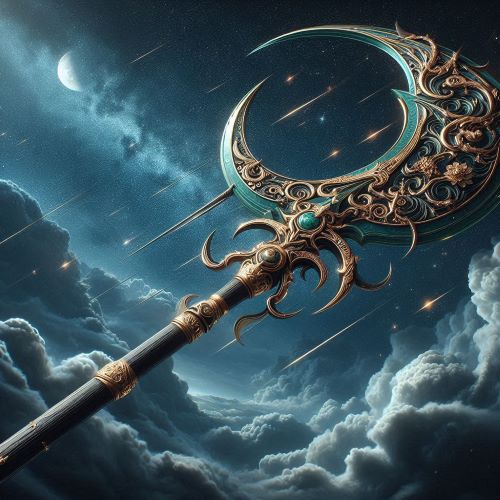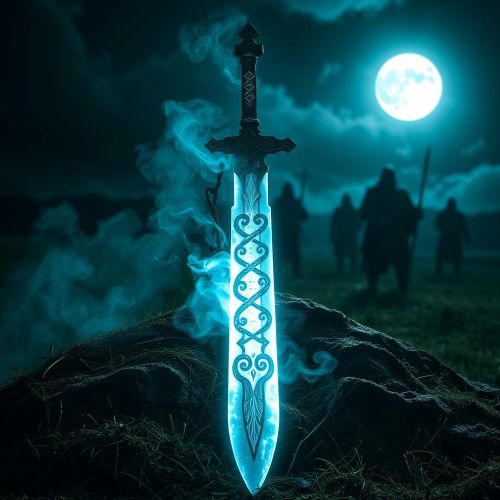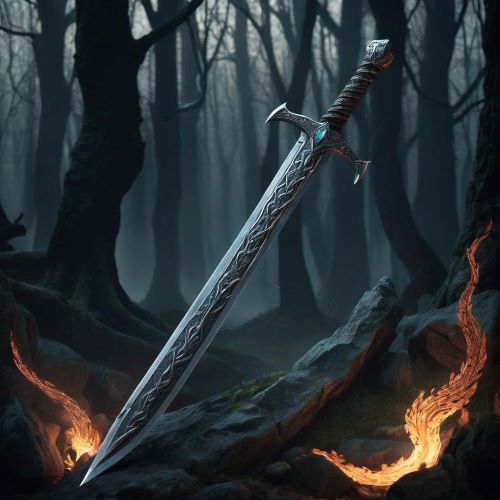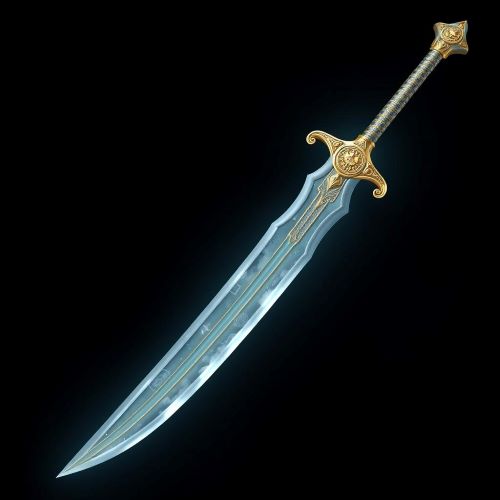Sun Blade of Tezcatlipoca : The Radiant Blade
Sun Blade of Tezcatlipoca
Introduction
The Sun Blade of Tezcatlipoca holds a unique place in Aztec mythology, blending ancient symbolism with modern interpretations of divine weaponry. Tezcatlipoca, the powerful god known as the “Smoking Mirror,” is often associated with the night sky, war, sorcery, and transformation. Though traditional texts do not directly reference a weapon known as the Sun Blade, the concept arises from Tezcatlipoca’s association with obsidian—used in ritual knives and mirrors—and the cosmic role he played in shaping and challenging the celestial order. The Sun Blade, as a modern mythological concept, captures the essence of Tezcatlipoca’s duality: both creator and destroyer, light bearer and shadow walker.
Origins
The mythological foundations of the Sun Blade of Tezcatlipoca are deeply rooted in the Aztec cosmogony. Tezcatlipoca was one of the four creator gods born of Ometeotl, embodying the northern direction and ruling over the first era of creation, known as the First Sun or “4 Jaguar.” This primordial age ended in chaos, symbolized by jaguars consuming the giant inhabitants of that world. In this turbulent period, Tezcatlipoca was said to wield immense power, and it is within this context that the concept of a radiant obsidian blade emerges.
Obsidian, a volcanic glass revered by the Aztecs, was a sacred material believed to connect the physical and spiritual realms. The Sun Blade, imagined as forged from obsidian infused with solar fire, represents Tezcatlipoca’s command over the forces of creation and destruction. Mythological reconstructions often place its forging in the divine realms, where celestial artisans shaped it under his guidance. Whether real or symbolic, the weapon embodies Tezcatlipoca’s transition from solar deity to shadow god, encapsulating the birth of light from primordial darkness.
Think you know your myths and legends? Dive into the world of ancient stories and test your knowledge with our engaging quizzes on Mythlok!
Powers
The Sun Blade of Tezcatlipoca is imagined as more than a weapon—it serves as a divine instrument channeling immense cosmic energy. Reflecting the dual aspects of Tezcatlipoca’s dominion, the blade holds the power to illuminate and incinerate, purify and deceive. It can unleash beams of concentrated sunlight capable of vanquishing enemies, while also casting a paradoxical flame that fuses darkness with fire—known as the shadowflame.
Its core, made of obsidian, functions as a reflective surface imbued with prophetic qualities. This allows the wielder to glimpse into hidden truths, spy across time, and reveal concealed intentions. Just as Tezcatlipoca’s mirror allowed him to see into human hearts and predict destinies, the Sun Blade amplifies these visionary abilities. It is believed to possess the capability to slice through temporal veils, opening glimpses into past cosmic ages or alternate realities, echoing the god’s control over destiny and transformation.
Owners/Users
While Tezcatlipoca is the primary bearer of the Sun Blade, various figures in myth and reinterpretation have come into contact with its divine energy. The blade, as part of cosmic allegory, occasionally passes between divine hands during mythic confrontations. In narratives depicting the eternal rivalry between Tezcatlipoca and his brother Quetzalcoatl, the Feathered Serpent briefly wrests the blade from his sibling in a struggle over control of the cosmos. This act symbolizes the fleeting triumph of order over chaos, light over shadow, before balance is once again restored.
In some ceremonial interpretations, particularly those surrounding the Festival of Toxcatl, the chosen impersonator of Tezcatlipoca—a youth known as the Ixiptla—symbolically wields the blade. His role is not only to embody the deity but also to act out his death and renewal, carrying the sacred blade during the climactic ritual sacrifice.
There are also mythic figures such as jaguar priests, seen as earthly extensions of Tezcatlipoca’s will, who are said to have used replicas or ritualized versions of the blade in ceremonial contexts. Even Ehecatl, the god of wind, is occasionally attributed as a wielder in speculative stories, helping to disperse the blade’s energy across realms to maintain cosmic balance.
Instances used
The mythic uses of the Sun Blade align with pivotal events in Aztec cosmology. During the creation of the world, Tezcatlipoca, alongside Quetzalcoatl, battled the monstrous Cipactli. In this myth, the blade is imagined as the divine tool used to carve the creature’s body, forming the earth and sky. This act of dismemberment with an obsidian weapon reflects how sacrifice was intrinsic to creation in Aztec belief, with the blade becoming a metaphor for both the end and beginning of existence.
Another significant context is the Toxcatl festival, held annually in Tezcatlipoca’s honor. The central ritual involved the sacrifice of the god’s human representative, performed with an obsidian knife, which some interpretations connect to the Sun Blade. This ceremony dramatized the cyclical death and rebirth of Tezcatlipoca, his fall and return to power, mirroring the shifting sun and seasons.
Outside divine myths, the Sun Blade’s essence lives on through the ceremonial knives used in human sacrifices. These tools, adorned with carvings of deities and precious stones, were extensions of the gods’ power. Though lacking explicit magical abilities, they were regarded as instruments channeling divine will. Used in temples by priests, they ensured the continuity of life by appeasing the gods through blood offerings.
Modern reinterpretations also envision the blade being evoked during vision quests or spiritual journeys. Shamans, seeking to channel Tezcatlipoca’s power, would use obsidian mirrors and blades to connect with the deity. In these practices, the Sun Blade is not a weapon of physical war but a means of accessing divine insight, transformation, and internal balance.
Frequently Asked Questions
Lorem ipsum dolor sit amet, consectetur adipiscing?
Lorem ipsum dolor sit amet, consectetur adipiscing elit. Praesent convallis vestibulum justo, ac tincidunt nunc vehicula quis. Nullam id dolor quis orci malesuada feugiat. Curabitur aliquet libero at urna ullamcorper, ac ultricies nulla dapibus.
Lorem ipsum dolor sit amet, consectetur adipiscing?
Lorem ipsum dolor sit amet, consectetur adipiscing elit. Praesent convallis vestibulum justo, ac tincidunt nunc vehicula quis. Nullam id dolor quis orci malesuada feugiat. Curabitur aliquet libero at urna ullamcorper, ac ultricies nulla dapibus.
Lorem ipsum dolor sit amet, consectetur adipiscing?
Lorem ipsum dolor sit amet, consectetur adipiscing elit. Praesent convallis vestibulum justo, ac tincidunt nunc vehicula quis. Nullam id dolor quis orci malesuada feugiat. Curabitur aliquet libero at urna ullamcorper, ac ultricies nulla dapibus.
Lorem ipsum dolor sit amet, consectetur adipiscing?
Lorem ipsum dolor sit amet, consectetur adipiscing elit. Praesent convallis vestibulum justo, ac tincidunt nunc vehicula quis. Nullam id dolor quis orci malesuada feugiat. Curabitur aliquet libero at urna ullamcorper, ac ultricies nulla dapibus.
Lorem ipsum dolor sit amet, consectetur adipiscing?
Lorem ipsum dolor sit amet, consectetur adipiscing elit. Praesent convallis vestibulum justo, ac tincidunt nunc vehicula quis. Nullam id dolor quis orci malesuada feugiat. Curabitur aliquet libero at urna ullamcorper, ac ultricies nulla dapibus.
Watch
Source
Meehan, E. (2022). Tezcatlipoca. Mythopedia. Retrieved from https://mythopedia.com/topics/tezcatlipoca
van de Kerkhof, M. (2024). Tezcatlipoca: Corner Stone of Aztec Mythology. History Cooperative. Retrieved from https://historycooperative.org/tezcatlipoca
Wikipedia contributors. (2024). Tezcatlipoca. Wikipedia. Retrieved from https://en.wikipedia.org/wiki/Tezcatlipoca
Mythology Worldwide. (2024). Aztec Mythology: The Legend of the Four Tezcatlipocas. Retrieved from https://mythologyworldwide.com









